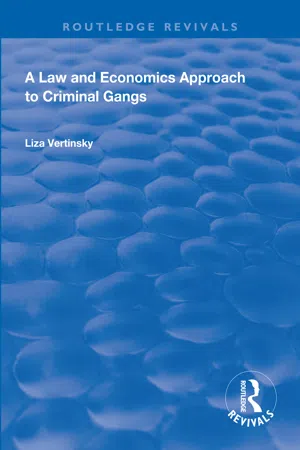
- 236 pages
- English
- ePUB (mobile friendly)
- Available on iOS & Android
A Law and Economics Approach to Criminal Gangs
About This Book
First published in 1999. This book provides a law and economics approach towards criminal gangs which integrates the tools of economic modelling with criminal law in order to understand and address a contemporary law enforcement problem. The book draws upon ideas from economics, law and law enforcement to investigate the nature and organizational structure of criminal gangs. Law and economics are employed in varying combinations and at varying levels of specificity to generate insights into the organization and behaviour of criminal gangs. These insights are applied to evaluate alternative legal approaches and to inform the design of a new criminal law approach towards criminal gangs. Attention is focused on the organization of criminal street gangs, both because the growth and increasing sophistication of these gangs offer special challenges for law enforcement and because of the potential contributions which such an understanding could yield for economists who have traditionally focused on the organizational structure of legitimate enterprises.
Frequently asked questions
1 A Law and Economics Approach to Group-based Criminal Laws and Criminal Street Gangs
Introduction
I. The American Criminal Law Approach to Group-based Crimes
Table of contents
- Cover
- Half Title
- Dedication Page
- Title Page
- Copyright Page
- Table of Contents
- Preface
- 1 A Law and Economics Approach to Group-based Criminal Laws and Criminal Street Gangs
- 2 Modeling Criminal Street Gangs as Organizations
- 3 The Economic Organization of Drug Selling Gangs